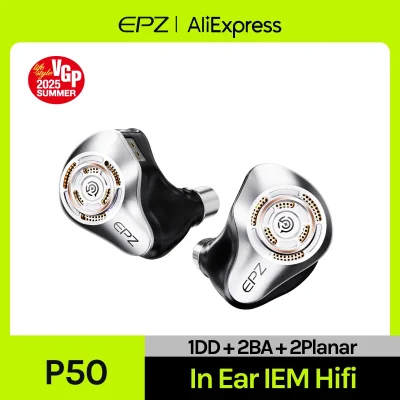EPZ P50 and Yu9 Que use 1DD+2BA+2Planar and 1DD+3BA driver setups respectively. EPZ P50 costs $205 while Yu9 Que costs $409. Yu9 Que is $204 more expensive. Yu9 Que holds a clear 0.9-point edge in reviewer scores (7.2 vs 8.1). User ratings place EPZ P50 at 9.5 and Yu9 Que at 8.5. Yu9 Que has better bass with a 0.6-point edge, Yu9 Que has slightly better mids with a 0.4-point edge, Yu9 Que has better treble with a 0.6-point edge, Yu9 Que has significantly better dynamics with a 1.3-point edge, Yu9 Que has better soundstage with a 0.7-point edge and Yu9 Que has slightly better details with a 0.3-point edge.
Insights
| Metric | EPZ P50 | Yu9 Que |
|---|---|---|
| Bass | 7.6 | 8.2 |
| Mids | 7.9 | 8.3 |
| Treble | 7.4 | 8 |
| Details | 7.6 | 7.8 |
| Soundstage | 7.3 | 8.1 |
| Imaging | 7.7 | 7.9 |
| Dynamics | 6.5 | 7.8 |
| Tonality | 7.2 | 8.3 |
| Technicalities | 7.2 | 8 |
EPZ P50 Aggregated Review Score
Average Reviewer Scores
Average Reviewer Score:
7.2Generally Favorable
Yu9 Que Aggregated Review Score
Average Reviewer Scores
Average Reviewer Score:
8.1Very Positive
Reviews Comparison
EPZ P50 reviewed by Jaytiss
Jaytiss Youtube Channel
Buy EPZ P50 on Aliexpress
Ad
Price: $199
Buy EPZ P50 on Aliexpress
Yu9 Que reviewed by Jaytiss
Youtube Video Summary
The YU9 Que sports a premium, durable resin shell in pure black with a metallic-feeling faceplate and a comfortable design featuring an anti-tragus catch. While the build itself feels handsome and unique, the included cable is criticized as wimpy and unpleasant, with a strong suggestion to upgrade it. Accessories are deemed solid, including a nice selection of tips and a particularly praised case with a soft, luxurious interior.
Sonically, the YU9 Que earns immense praise for its exceptional tuning, described as clean, resolute, and non-fatiguing. It delivers strong, textured bass that avoids being overwhelming, coupled with extremely well-done upper mids. While not class-leading in technicalities like micro-detail or instrument separation, its tonal balance is considered sophisticated and reminiscent of far more expensive sets like the Annihilator, even surpassing the Monarch MKII in tuning preference. It's highlighted as a fantastic all-rounder with a smooth, agreeable signature suitable for long listening sessions.
Despite its modest single dynamic driver + 3BA configuration and $409 price point, the YU9 Que is declared a very special and unique IEM, worthy of the hype it received. The review concludes it's a price leader and a highly competent package from a small brand, offering outstanding value and a beautiful, well-executed design that makes it an easy recommendation for those seeking a smooth, non-fatiguing sound.
Jaytiss Youtube Channel
EPZ P50 reviewed by Kois Archive
Youtube Video Summary
The EPZ P50 arrives as a ~$200 tribrid with a slick presentation: FR graph on the box, a puck-style case, plenty of tips (oddly two identical sets), and a nice microfiber cloth. Build leans premium with a semi-open back and a faceplate that gives “arc reactor” vibes. The custom shell offers a secure fit for most, though very small ears—or anyone sensitive to an inner wing—may need caution. The modular cable (3.5/4.4 mm) is practical yet slightly stiff and retains some memory; isolation is typical of sealed IEMs despite the semi-open styling.
Sonically, the P50 goes for a warm-balanced tuning. Bass quality impresses: bouncy with deep sub-bass reach, prioritizing texture and control over sheer quantity (more thump is possible via an impedance adapter). Mids read natural with a touch of warmth—male vocals shine—while female vocals can feel a bit lean due to a more relaxed upper-mid energy. Treble is smooth, inoffensive, and “planar-clean” without planar timbre, with only a slight wish for more top-end extension.
Technical performance is the star. The micro planars pull out micro-detail unusually well for the price; imaging, separation, and overall resolution feel confidently executed, making guitars pop and busy mixes easy to parse. That clarity translates to gaming, where positional cues and crowded soundscapes (think battle royale chaos) remain intelligible—worthy of a two-controller gaming nod. Overall, the EPZ P50 is a solid contender at this price: balanced tuning with standout detail retrieval and imaging, tempered only by mids that play it a little safe. For listeners unbothered by a gentler upper-mid lift, it’s well worth the money—a two-star recommendation.
Kois Archive Youtube Channel
Yu9 Que reviewed by Kois Archive
Youtube Video Summary
Yu9 Que arrives with a surprisingly premium unboxing: a crush-resistant carrying case with plush padding, an IEM pouch, microfiber cloth, cable clip, and two ear-tip sets (standard silicone and more premium liquid silicone). A quirky 3D-printed nameplate with serial number and a faceplate etched in a topographic-map motif give it character. The shell is on the larger, wider side—comfortable for many, but small ears should test fit first. The stock cable is just okay (some memory, no chin slider), though it’s offered in 3.5 mm or 4.4 mm terminations.
Tonally, this is a neutral-reference set with a tasteful bass lift—clean impact without throwing off balance. Sub-bass has satisfying thump and texture, though bass-heads coming from sets like Kiwi Ears Punch may find it polite. The mids sit even and accurate—no “vocal magic,” yet clearly above average. Treble stretches well into the air with a touch of brightness that adds crispness and a slightly clinical edge, staying shy of fatiguing. Technical chops are the draw: a decently wide soundstage (roughly 3–4/5 by comparison), standout 3D imaging, and strong resolution/separation make it excellent for gaming—worthy of a two-controller nod—though ultimate detail still trails pricier kilobuck options.
Versus peers: Moondrop Dusk (DSP) is warmer with bass that hits a bit harder, while Yu9 Que is the more neutral, reference-leaning take. Elysian Pilgrim offers smoother treble, but Yu9 Que counters with better bass grip, stage, and imaging. AFUL Performer 7 tilts mild V; choose it for extra mid-bass and forward treble, otherwise Yu9 Que wins on technicality. Mega 5 EST chases the meta target yet stumbles in bass/treble; NiceHCK Rockies refines that approach and might be the more exciting alternative if spending slightly more. Bottom line: the hype is justified—a superb all-rounder around $400 with only the cable begging for an upgrade. It’s a clear pick for neutral/reference fans, though those seeking more “fun” might look elsewhere; call it a pragmatic, two-star recommendation amid a crowded market and likely pre-order waits.
Kois Archive Youtube Channel
EPZ P50 reviewed by Jays Audio
Youtube Video Summary
The EPZ P50 comes in hot as a new tribrid and a potential $200 neutral benchmark, trading sterile restraint for a more vocal-centric presentation. Versus the MEGA5EST, vocals sit a touch more forward—adding emotional weight and clarity—while the MEGA5EST still edges it on sheer smoothness and EST “air.” Compared to Meteor, the P50 fills in the lower mids, dials back 1–3 kHz glare, and opens the top end a bit; Meteor stays a hair softer up top. The catch is bass: the P50’s DD is competent but not a sub-bass shaker—expect clean rather than authoritative slam.
Against peers, the P50 sounds fuller and more natural than Supermix 4 (which is brighter and more “hi-fi” energetic), and it trades blows with Odyssey: Odyssey brings better bass texture and treble micro-detail, while the P50 delivers superior vocal clarity and a touch more air. It excels at mid-volume listening—Volume S needs more gain to bloom—and outclasses lighter, air-tilted sets like “K4” style tunings when male vocals or body are the priority. Accessory game is strong too: a nicer cable and a genuinely sturdy hard-leather case sweeten the deal. Not the most “unique” flavor and not for bassheads, but as a balanced, clean, vocal-forward option around $200, P50 is an easy recommendation for those chasing neutrality without the vanilla.
Jays Audio Youtube Channel
Yu9 Que reviewed by Jays Audio
Youtube Video Summary
YU9 Que presents a balanced, almost neutral tuning with a tasteful touch of mid-bass for warmth and punch. Treble is clean and controlled—more clarity than “sizzle”—so detail comes through without harshness, while mids keep vocals natural rather than forward or thin. Technical performance sits in the “solid for the price” camp: separation and imaging are tidy, but not the kind of hyper-etched sparkle that chases wow factor.
In practice, it shines with slower pop, R&B, acoustic and vocal-centric tracks where its coherence and smoothness pay off; those seeking big sub-bass drama or ultra-aerated treble fireworks may find it a touch polite. Versus brighter, more contrasty sets, the Que trades spectacle for musicality and long-session comfort, making value hinge on whether a refined, low-fatigue signature is preferred over maximum excitement at the price point.
Jays Audio Youtube Channel
EPZ P50 reviewed by Paul Wasabii
Youtube Video Summary
The EPZ P50 is a five-driver open-back hybrid (1DD + 2BA + 2 micro-planars) that arrives with a solid accessory kit and a sensible price. The tuning is the highlight: a vocal-centric balance that avoids the over-energetic tilt of some Harman-leaning sets, while keeping a clean background and strong clarity. Sub-bass is trimmed for control, mid-bass adds body, and the result is natural male vocals and a presentation that feels both transparent and organized.
Upper mids rise earlier for familiar presence, and treble is extended by the micro-planars yet kept in check for wider appeal than brighter peers. Resolution is high for the class and the set can be revealing, sometimes asking for a touch more volume and occasionally sounding a bit unforgiving on hot masters. Bass is snappy rather than booming, trading rumble for speed and definition to keep the midrange clean.
Stage and imaging are standouts: spacious, precise, and helped by bass control and the open shell design. Compared with typical u-shaped ~$200 hybrids, this tuning prioritizes mids and coherence, showcasing a clear, extended top without brittleness. As a sub-$100 tribrid, the P50 delivers impressive value and feels like a sign of what is to come in this segment.
Paul Wasabii Youtube Channel
Yu9 Que reviewed by Paul Wasabii
Youtube Video Summary
At ~$400, YU9 Audio Que sets a new bar for the bracket: a 1DD+3BA hybrid with a modest bass shelf, slightly forward mids, and linear treble extension that sounds more speaker-like than typical IEMs. The presentation is exceptionally polished and quiet-backgrounded, yielding crisp separation, convincing imaging, and staging in depth, width, and height that resembles far pricier gear.
The low end brings tactile mid-bass impact with deep, controlled sub-bass, pairing naturally with that extended, peak-free top end; the result is a true playlist killer across EDM, rock, vocal, and classical. Nitpicks exist: mids can sit a touch forward depending on track and the set rewards a slightly higher volume and a secure, deeper fit, while V-shape fans may find it too boring.
Compared with favorites like Dusk, Cadenza 4, and Volume S, Que keeps their strengths but fixes common complaints by delivering fuller bass weight, cleaner openness, and more realistic attack and dynamics. It does not need giant-killer claims to stand out; at this price it is simply class-leading.
Paul Wasabii Youtube Channel
EPZ P50 reviewed by Gizaudio Axel
Yu9 Que reviewed by Gizaudio Axel
Youtube Video Summary
Build & accessories: a hybrid 1DD + 3BA set priced around $399 with a spacious zipper case, multiple silicone tips, pouches, cleaning cloth, and shirt clip. The faceplate’s wavy, stone-like texture looks premium, and the shells use a 2-pin connector. The downside is the stock cable: it’s springy, only in 4.4 mm, and feels below the tier. Fit is serviceable but not ideal—the shell isn’t the most ergonomic, the nozzle lacks a lip, and seating a deeper fit can take a moment; once set, stability is good and tips stayed secure in use.
Sound: this isn’t a “new-meta” curve; it’s a unique, lively tuning. Bass is punchy, dynamic, and highly textured—more physical in practice than the graph suggests, with excellent impact and kick-drum authority. An early rise after 1 kHz pushes vocals front and center for an intimate, engaging presentation without tipping into shout. Treble is refined, sparkly, and well-extended: it is a bright set but avoids harshness, peakiness, sibilance, and fatigue, delivering crisp cymbals and defined transients even for rock and metal at any volume. Technicalities are class-leading under $500 with standout detail retrieval and separation; the one wish is a larger soundstage.
Comparisons & verdict: the Elysian Apostle still wins on bass texture/impact, treble refinement, and overall resolution, but the Yu9 Que offers a convincing “Apostle flavor” at a lower price. Versus Elysian Pilgrim, the Que is fuller and bassier, while Pilgrim’s treble is tamer; versus Volume S, the Que is cleaner, brighter, more detailed as the Volume S trends warmer with more neutral treble; against Dusk DSP, Dusk sounds more natural/balanced but the Que feels more fun and technical. Recommended for those who crave clarity, sparkle, and engagement without fatigue; less ideal if treble-sensitive or preferring a warm, relaxed tonality, and worth demoing for comfort. A top contender and serious gatekeeper around $400—final rating: 4.5/5 with a strong recommendation.
Gizaudio Axel original ranking
Gizaudio Axel Youtube ChannelEPZ P50 reviewed by Head-Fi.org
Yu9 Que reviewed by Head-Fi.org
EPZ P50 reviewed by Web Search
The EPZ P50 is a tribrid with a 10 mm dynamic driver, two balanced armatures, and two micro planar drivers, implemented in a semi-open back shell and a three-way crossover—an uncommon configuration at this price tier. Listings and spec sheets place impedance at 20 Ω and sensitivity around 106 dB, with interchangeable 3.5/4.4 mm plugs and 0.78 mm 2-pin connectors, positioning it as a flexible daily-carry IEM near the $200 mark.
Subjectively, multiple reviews converge on a neutral-with-bass-boost presentation: sub-bass is tight and weighty when called for, mids stay clear and slightly forward, and treble is extended with extra energy from the planar tweeters. This yields a clean center image and articulate vocals without obvious mid-bass bloom, though the upper-treble emphasis can read “sharper” on some recordings.
Technical performance is competitive for the class: reviewers note solid imaging, above-average separation, and a stage that feels wider than typical sealed IEMs—qualities plausibly aided by the semi-open design and multi-way damping. Trade-offs include reduced isolation versus closed shells and a treble tilt that may fatigue treble-sensitive listeners at high volumes, but overall resolution and micro-detail retrieval punch above its price.
Yu9 Que reviewed by Web Search
The YU9 Que is a hybrid IEM using 1 dynamic driver + 3 balanced armatures, positioned in the mid-upper price tier with an MSRP around $399. Retail listings confirm the configuration (10 mm LF DD with three Knowles BA units) and current pricing in USD and MYR, placing it among competitors that emphasize tonal refinement over sheer technical fireworks.
Community impressions describe a balanced/neutral tonality with a tasteful bass lift, smooth upper-mids that avoid glare, and treble that leans non-sibilant. Subjective reports on Head-Fi and Reddit consistently frame the Que as an all-rounder that favors coherence and long-term listenability over maximum micro-detail.
Technically, listeners note solid imaging and macrodynamics with competent detail retrieval, though not class-leading for the price. The manufacturer has also published frequency-response plots (IEC711 and BK5128 rigs), which aligns with the community’s take that the Que targets a broadly neutral/balanced signature rather than an aggressive V-shape. Overall value is credible at its MSRP if you prioritize tonal balance and comfort over ultra-analytical presentation.
EPZ P50 (more reviews)
EPZ P50 reviewed by Audio Amigo
Youtube Video Summary
EPZ P50 comes as a tribrid at $185 with a surprisingly complete kit: a sturdy leatherette case, modular 3.5/4.4mm terminations, three silicone tip sets, and a cleaning cloth. The resin shells are semi-custom with aluminum faceplates; comfort is generally good but anatomy-dependent, and the stock cable—while well finished—runs on the stiff side. A standout twist is the factory customization option (~$225 total for the “Grindphones” style), which notably doesn’t alter the tuning in any meaningful way. The set is easy to drive, shows minimal change with impedance adapters (a touch warmer/more vocal-forward), and avoids pressure issues thanks to smart internal venting.
Sonically, tuning sits as a controlled, mild V: bass is just north of neutral with pleasing texture and impact, mids stay clean with an engaging female-vocal emphasis, and treble adds airy sparkle without turning tizzy—though insertion depth can trigger length-mode variability for some ears. Technical chops impress at the price: detail retrieval punches up, imaging is precise with good separation, and stage reads average but coherent. Against peers, P50 feels more resolving than Kiwi Ears K4 (trades bigger bass/sparkle for better mid clarity), brighter and more vocal-present than the neutral-leaning Ziigaat Lush, and echoes a Dunu Da Vinci vibe with less bass. Verdict: tremendous value and a terrific pick for vocal-centric libraries—highly recommended to audition first if treble sensitivity or fit quirks are a concern.
Audio Amigo Youtube Channel
EPZ P50 reviewed by Super* Review
Youtube Video Summary
EPZ’s P50 feels like a breakout for the brand: a compact, medium-small shell with a vented faceplate that’s marketed as “open-back,” yet isolates like a typical IEM. The unboxing is tidy at this price—carry puck, a real microfiber cloth, and two sets of generic tips—while the modular cable (screw-lock swappable termination) is handy if a bit thin, stiff, and kink-prone; the 2-pin plug sits slightly proud of the socket and the “R” marking is visible on the outside. The long nozzle (~5.5 mm diameter) can push fit depth, so shorter tips (e.g., NF Audio-style) help; once set, stability and comfort are excellent. Overall build looks clean and modern, if a touch editorial compared with EPZ’s other shells.
Sonically, P50 embraces the current tilted diffuse-field “new meta” with a mostly neutral, natural presentation and a later-rising, sub-bass-centric lift that gives bounce rather than mid-bass thump. There’s a hint of extra presence around the 4–5 kHz region that adds macro-contrast—vocals pop with definition and separation is crisp—while upper treble stays safe: cymbals are clean but a bit light in weight. Bass is tight and incisive rather than slammy; micro-texture on vocals is good, though the set favors that big, “stagey” contrast over ultra-fine grain. It’s easily EPZ’s best tuning so far: clear, organized, and engaging without drifting from neutral-ish aims.
Against peers, Kiwi Ears K4 tracks a similar target but sounds lower-contrast and can blur on dense mixes; P50 hits harder on transients, images more cleanly, and keeps busy tracks sorted, while K4 offers a richer midrange with “frothier” treble. Versus the Binary Chopin, Chopin is warmer, fuller, and more mid-bass driven—more “analog” and atmospheric—with deeper perceived space but a bulkier fit; P50 is leaner, clearer, and the least bass-forward of the three. Verdict: a confident 4/5 for delivering a small, comfy fit and a clean, contrasty neutral that competes squarely around $200–$250. If the brief is “neutral with a bit of drama,” this is a strong pick—and a promising sign of where EPZ can go next.
Super* Review original ranking
Super* Review Youtube ChannelEPZ P50 reviewed by Tim Tuned
Tim Tuned Youtube Channel
Yu9 Que (more reviews)
Yu9 Que reviewed by Audionotions
Yu9 Que reviewed by Fox Told Me So
Tuning is clean, neutral, and slightly V-shaped: bass is tight, bouncy, and textured; mids sit slightly forward thanks to extra 700 Hz–2 kHz gain, giving vocals a bigger image; treble leans bright with a 4–5 kHz push for clarity, rolling off naturally rather than chasing EST-style air. Sibilance can appear (on “th” or “tsu”), but not harsh.
Stage favors width over depth—impressively wide at the price, with neat, well-ordered placement and strong separation. Resolution is crisp, background clean, every note clearly etched.
Fox Told Me So original ranking
Fox Told Me So Youtube ChannelYu9 Que reviewed by Precogvision
Youtube Video Summary
Yu9’s Que lands as a “safer Annihilator”: a warmer, scaled-back take that pushes ample sub-bass while keeping the rest tastefully controlled. The low end feels liquidy and bouncy, underpinning an aggressive 1–3 kHz rise with a gentle 3–5 kHz taper, so vocals sit upfront and crisp yet remain remarkably smooth thanks to the extra low-end warmth. Treble is slightly scooped around 5–6 kHz and then climbs in small, well-placed peaks out to ~15–18 kHz, yielding excellent extension that feels on par with sets like Moondrop Variations in this range.
What makes it pop is the value proposition: at $400, the overall resolution, tonal balance, and staging read far pricier—more like the $700–800 bracket. With its engaging sub-bass lift, lucid mids, and airy yet controlled top end, Que comes off as a polished, crowd-friendly tuning that still excites detail chasers. If momentum holds, this looks like the next big thing around the $400 mark.
Precogvision Youtube Channel
EPZ P50 Details
Driver Configuration: 1DD+2BA+2Planar
Tuning Type: Neutral with Bass Boost
Price (Msrp): $205
Support our free service! Buying through our affiliate links costs you nothing extra:
Yu9 Que Details
Driver Configuration: 1DD+3BA
Tuning Type: Neutral with Bass Boost
Brand: Yu9 Top Yu9 IEMs
Price (Msrp): $409
Support our free service! Buying through our affiliate links costs you nothing extra:
EPZ P50 User Review Score
Average User Scores
Average User Score:
Based on 1 user reviews
9.5Exceptional
Yu9 Que User Review Score
Average User Scores
Average User Score:
Based on 1 user reviews
8.5Excellent
EPZ P50 Gaming Score

Gaming Score & Grade
- The gaming score is prioritizing technical capabilities of the IEM (Separation, Layering, Soundstage) and good value.
Gaming Score
7.2Gaming Grade
A-Yu9 Que Gaming Score

Gaming Score & Grade
- The gaming score is prioritizing technical capabilities of the IEM (Separation, Layering, Soundstage) and good value.
Gaming Score
7.9Gaming Grade
AEPZ P50 Scorings
Average Technical & Tuning Grades
Average Tunign Grade
A-- The tonal character feels settled and versatile, with just a few gentle bumps. You can listen for hours without fatigue.
Average Technical Grade
A-- You get a controlled, composed performance, marrying decent clarity with a still-modest sense of space. A safe technical performer for the price bracket.
Yu9 Que Scorings
Average Technical & Tuning Grades
Average Tunign Grade
A+- Tuning feels refined, blending frequencies with convincing realism and engagement. Transitions between registers feel effortless.
Average Technical Grade
A+- You get an articulate, polished performance with immersive stage depth and great control. There's a sense of polish across the whole spectrum.
EPZ P50 User Reviews
Share your experience and build your personal ranking list.
You need to be signed in to write your own reviewKillabuck.
Pros
No roughness, Natural timbre, Balanced signature, good note density, Very good consistency, comfortable to use, Good cable, Technically amazing, good accessories, good tips, good transparency, good brightness, tactile bass, not much warmth, nice voices.Cons
None.Yu9 Que User Reviews
Share your experience and build your personal ranking list.
You need to be signed in to write your own reviewTastefully tuned IEM. It gives some unique colorations to the sound, making vocals sound pretty crisp and clean but in a tasteful way. Add a very satisfying amount of bass (including mid-bass!). Treble is top-notch.
Pros
Tuning, especially bass and treble. But mids do not disappoint as well.Cons
I wouldn't describe this as neutral or even reference sounding. Soundstage could be wider.Find your next IEM:
IEM Finder Quiz
newIEM Comparison Tool
newVS




























